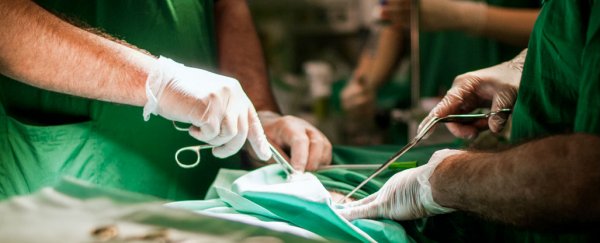Remember back in February when Italian surgeon and neuroscientist Sergio Canavero announced plans to perform the first ever human head transplant procedure in December 2017, much to the chagrin of sane and reasonable scientists everywhere?
Well, the slow and twisted march towards an experiment that almost no one wants to see happen has just taken yet another step forward with the announcement this week that Ren Xiaoping, a surgeon from the Harbin Medical University in China, would be partnering with Canavero to perform the controversial procedure.
The project already has a volunteer guinea pig lined up: Valery Spiridonov, a 30-year-old Russian man with muscular atrophy who announced back in April that he's willing to have his head removed and connected to another person's body. "My decision is final and I do not plan to change my mind," he told The Daily Mail at the time of the announcement.
Now at a recent "Frontier Science" seminar in northeast China, Canavero says he's managed to recruit a head surgeon to help him not only perform the controversial procedure, but to figure out exactly how they're actually going to do it. "Dr Ren is the only person in the world able to lead this project," Canavero told the press. "With its outstanding organisational ability and group operational ability, China might be the best choice to carry out head transplants."
Anyone who's already delved into the sordid world of head transplantation will know the name Ren Xiaoping well - since 2013 the man has conducted 1,000 head transplants on mice and has announced plans to perform the same operation on primates later this year.
Which is ambitious enough on its own, because as The Wall Street Journal reports, while he's been able to give all these mice new heads, with which they can successfully breath, drink, and see, the 10-hour operation has yet to result in any hybrid mouse living longer than a few minutes.
You think he'd try to figure out how to give these poor mice a little bit more time in their new bodies before rushing off to perform this horrible experiment on a monkey, but Xiaoping says he's been perfecting the procedure, particularly when it comes to feeding oxygenated blood from the brains to their new bodies. But even then, he told The Wall Street Journal that he hopes the primates will live, "at least for a little while".
It's been almost five decades since the first 'successful' head transplant. In 1970, the head of a monkey was placed onto the body of another at the Case Western Reserve University School of Medicine in the US, and this hybrid was able to live via assisted breathing for nine days.
Helen Thomson described the procedure Canvero intends to use at New Scientist back in February:
"The recipient's head is … moved onto the donor body and the two ends of the spinal cord - which resemble two densely packed bundles of spaghetti - are fused together. To achieve this, Canavero intends to flush the area with a chemical called polyethylene glycol, and follow up with several hours of injections of the same stuff. Just like hot water makes dry spaghetti stick together, polyethylene glycol encourages the fat in cell membranes to mesh."
We will remain skeptical to the end, and as Hunt Batjer, president elect of the American Association for Neurological Surgeons, told The Independent, it's not something Spiridonov should have to go through with, even if he's convinced himself it's his best option. "I would not wish this on anyone," said Batjer. "I would not allow anyone to do it to me as there are a lot of things worse than death."
Here's Xiaoping talking about his mouse work:
